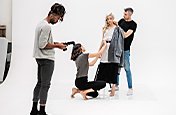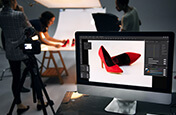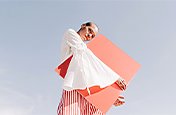An overhead view of flat lay photography.
Flat lay images tell stories through the arrangement of objects on a flat surface. Explore these photography tips to help you shoot compositions that are a cut above.
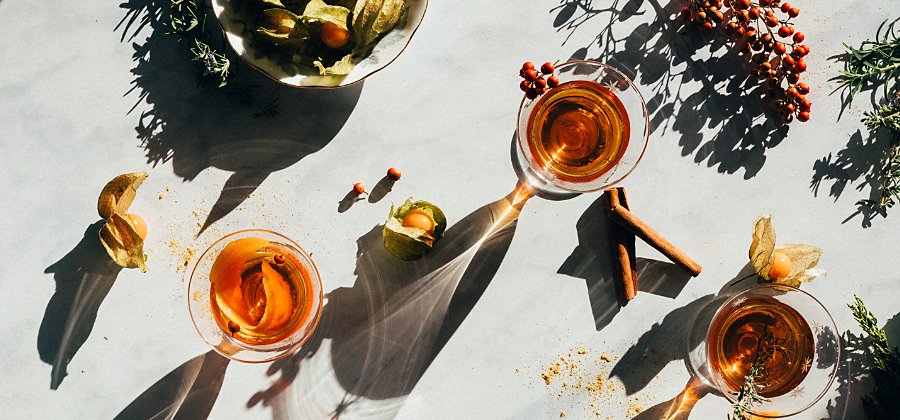
Photo by Heather Barnes
What is flat lay photography?
“Flat lay photographs are taken from a bird’s-eye view,” says blogger and photographer Heather Barnes. “It’s a top-down perspective of objects laid out on a surface in an aesthetically pleasing way.” This type of still life photography is popular on social media and can show everything from a layout of cosmetics to an array of camera accessories.
Use flat lay photos for just about anything.
“Flat lays can present a recipe story, a product story, or a ‘what’s in my bag’ story,” says photographer Doaa Elkady. “It’s a really versatile photography style that people gravitate toward, because it’s such an effective means of storytelling.”
Food photography is ideal for the flat lay technique because it provides a clear way to show a finished product alongside the ingredients. Product photography flat lays can showcase everything from tech to clothing. And DIY or craft flat lay photos are popular with many bloggers who use it to highlight the different items someone needs to complete a project.

Flat lay photos connect with audiences.
“It isn’t just people selling things. It’s people showing their audience what their world is like, how they stay organized, what a morning looks like for them, or what they take when they travel,” says Elkady. “Flat lay photography has been a great way for people to get to know the person behind the scenes and the world that they live in.”
Flat lays give the creator complete control over the composition, which means complete control over the message the image sends. With the right setup and some simple props, anyone can try the flat lay style at home. That makes it an accessible photography style, and it makes your content relatable, by showing how anyone with the right ingredients or tools can complete a recipe or project.
Equipment for photographing flat lays.
The most important items you need for flat lay photography include a good source of light and a way to hold your camera steadily above the items you shoot.
You can take a flat lay simply by holding your phone or camera over an arrangement of items on the floor. However, it can be a challenge to hold your camera completely still and level. A phone or camera tripod that can face downward with a small bubble level will be a huge help. Alternatively, a C-stand — a type of scaffolding for camera equipment — can hold your camera in addition to lights and other equipment.
If you plan to shoot a large array of items or shoot on a raised surface like a table, you may want to invest in a more high-quality tripod or C-stand that can rise up higher than cheaper options. This will give you enough space to shoot large compositions.
“I’ve found that my clients like those larger scenes with lots of objects and lots of storytelling,” says Elkady. “They can get more out of that image. When you have a larger scene, you’re able to crop it into micro scenes, and the content goes further for the client.”
Control your camera from your laptop or mobile device with a digital tethering app or physical cable. You can then adjust camera settings and see your image results without the need to take your camera off its tripod or C-stand.
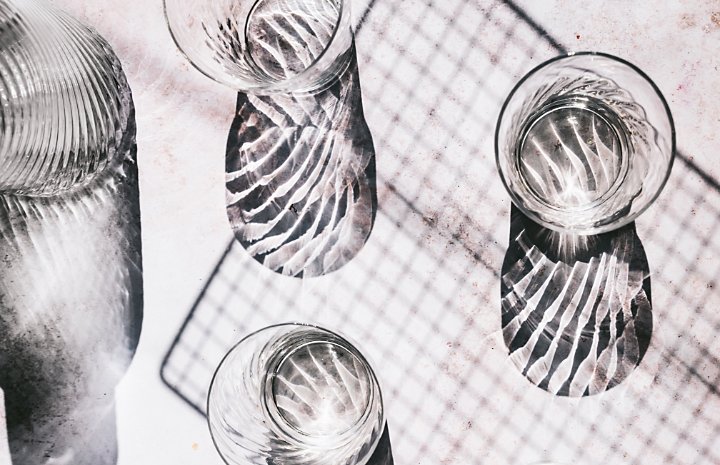
Photo by Doaa Elkady
Adjust your light.
When possible, set up your flat lay close to a window. The time of day may be a factor in your choice for the shoot depending on the location of your windows. Use a bounce board or reflector across from the window to direct the natural light back toward your setup. A piece of white poster board or foam board can make a great DIY bounce board. Or you can create a DIY lightbox.
If your windows don’t give you good light, use an artificial light tilted diagonally down toward your arrangement. Soften your light with a diffuser and put a bounce board or reflector across from it to get more even lighting.
Use the right camera lenses and features.
Enable the grid guide on your camera or iPhone and align your most important items on the cross-hairs of the grid. This will help you lay out your composition according to the rule of thirds. With the right lens, you can capture your entire flat lay without distortion.
“I usually use a 50mm lens,” says Barnes. “Because anything wider than that gets distorted around the edges, and anything closer in, like a 100mm, is just too close up.”
Prepping for great flat lay photos.
The flat lay style is built around a narrative. “I think of my story, and that helps me bring in my supporting elements,” says Elkady. “Then, after defining the materials, textures, and colors that I want, the fun starts and I begin to arrange.”
Decide on a story to tell, and you can elevate a simple shot of objects to a more engaging image. “Say you want to make a flat lay about oatmeal. Think of what else went into the oatmeal and what you do while you eat it,” says Barnes. “Adding a crossword puzzle and a cup of coffee tells more of a story than just a bowl of oatmeal.”

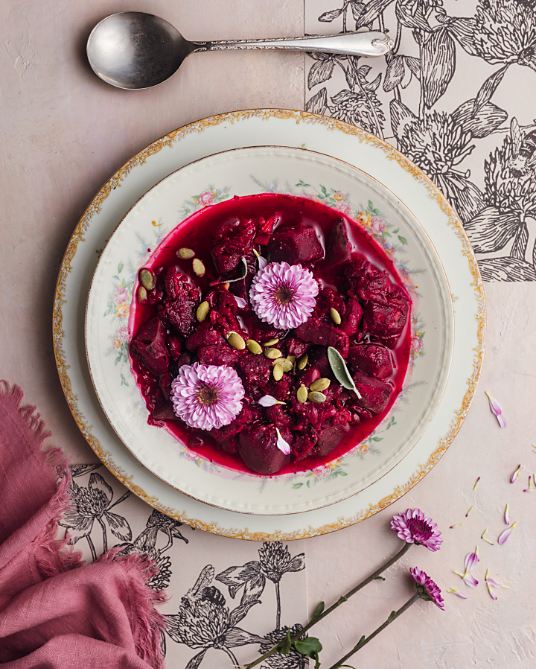
Photos by Heather Barnes
2. Find your hero item.
The hero item will be the focal point of your image. Use it as your starting point to build your composition and story. “Your hero should typically be the largest thing in your frame,” says Elkady. “You don’t want to overpower it or have anything else upstage it, because that’s where you want the eye to go.”
3. Add supporting elements, color, and texture.
Flat lay photography gives you complete control over your composition, so you can easily explore different themes. “You’re really able to get creative,” says Elkady. “You’ll want to focus on certain colors or create a scene based on a mood.” Texture plays a big role as well, so try props like fabric, paper clippings or confetti, and other loose materials.
In general, tall objects that look their most interesting from the side won’t make for great flat lay props. If you need to use a tall prop, lift and tilt it toward the camera lens. This can help with perspective and distortion.
Style the perfect shot.
It can be hard to know how to arrange your items. Start with the basic rules of photo composition, and don’t be afraid to have some of your items peeking partially into the frame. “I like to add in all the items I want to include. And then slowly take them away one at a time, just to simplify it,” says Barnes.
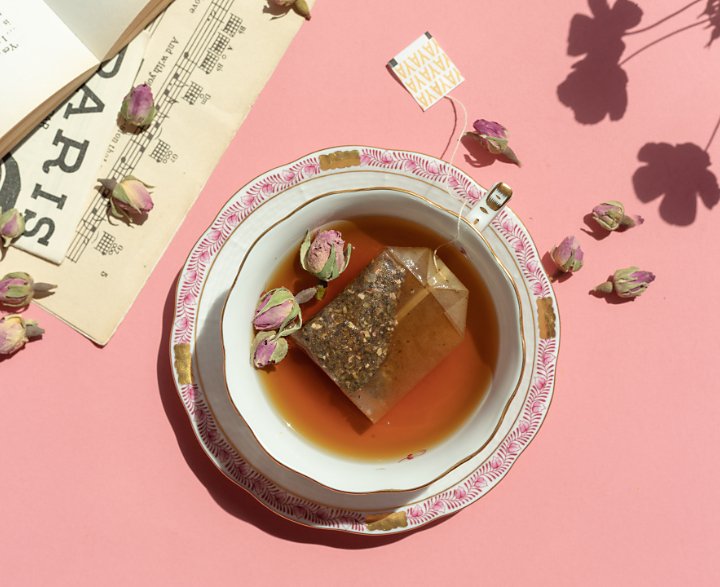
Photo by Heather Barnes
Don’t overcrowd your image.
Look for the right balance between a minimalist scene and a crowded scene. “A common mistake I see is either leaving too much empty space or adding things that don’t need to be there,” says Elkady. “It’s fun to use all your props, but they need to have a purpose and not take away from your subject.”
“Shapes guide our eyes naturally, so placing your supporting elements in ways that mimic the shapes in our everyday lives — you can’t go wrong with that,” says Elkady. Use the following layouts as a starting point:
- C-shaped flat lay
- V-shaped flat lay
- S-curve flat lay
- Triangular placement flat lay
- Circular or curved placement flat lay
- Parallel lines flat lay
Play with layers.
“Layering is a great way to add visual interest,” says Elkady. “For example, with food, you can layer a plate over another plate or put a dish on a tray. “This creates depth in the image and helps the scene look natural.” Cutting boards, hand towels, sheets of colored paper, or vintage books and magazines can all make wonderful flat lay background layers.
Editing flat lay photography.
From adjusting brightness to adding watermark graphics, photo editing in Adobe Photoshop Lightroom and adding elements in Adobe Photoshop can help you bring your flat lay vision to life.
Crop to improve the composition.
Cropping out items fully or partially can be the key to the perfect flat lay image. “I find that it’s important to have some objects only partially in the frame, so it looks like there’s a larger scene going on, and that draws the viewer into it,” says Barnes.
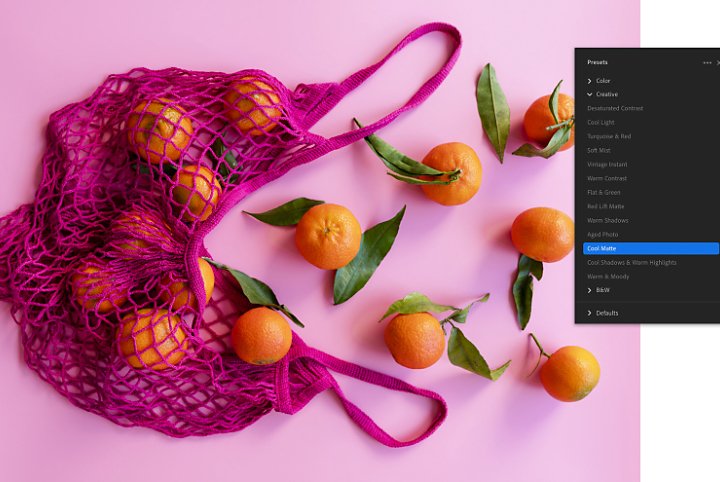
Establish your personal style with presets.
In Lightroom, you can adjust things like exposure, contrast, clarity, saturation, vibrance, shadows, white point, and black point. When you settle on a look you love, create your own preset that you can easily apply to your other shots.
Add overlays of text or graphics.
Easily add branding and text in Photoshop. Flat lay images often have room for text and logos, so they can make great backdrops for fliers, postcards, and digital banners for social media and the web.
Dive in and get started.
Take your first steps with this fun photography style and brainstorm to create story ideas and collect inspiration and props. “Moodboards are great,” says Barnes. “And I collect a lot of pieces of ephemera, like scraps of paper or fabric swatches.”
There’s so much room to create with flat lay photography. Follow your imagination and see what story you can tell with a few simple elements.
Contributors
Do more with Adobe Photoshop Lightroom.
Edit photos easily with Lightroom presets, Super Resolution, easily share photos from any device, and access your projects anywhere with cloud photo storage management.
You might also be interested in…
Minimalist photography: A beginner's guide.
Create photographs with clean lines, negative space, and only essential elements.
Get started in commercial photography.
Learn about commercial photography, and get tips for working with clients and tackling your shoot.
Expert product photography tips.
Learn how to polish up your products and get tips for capturing great product photography.
Fashion photography tips for beginners.
Learn what makes shooting fashion unique and see how to create stunning shots that shape culture.

